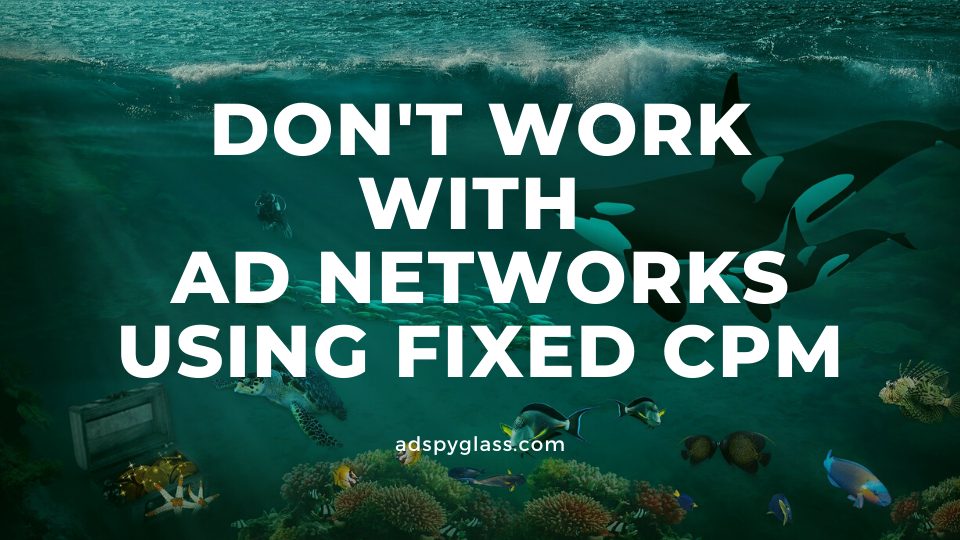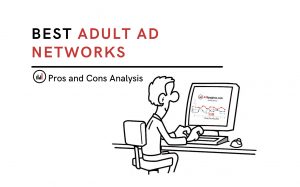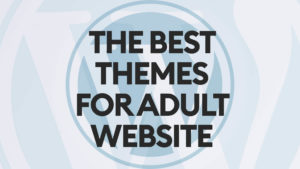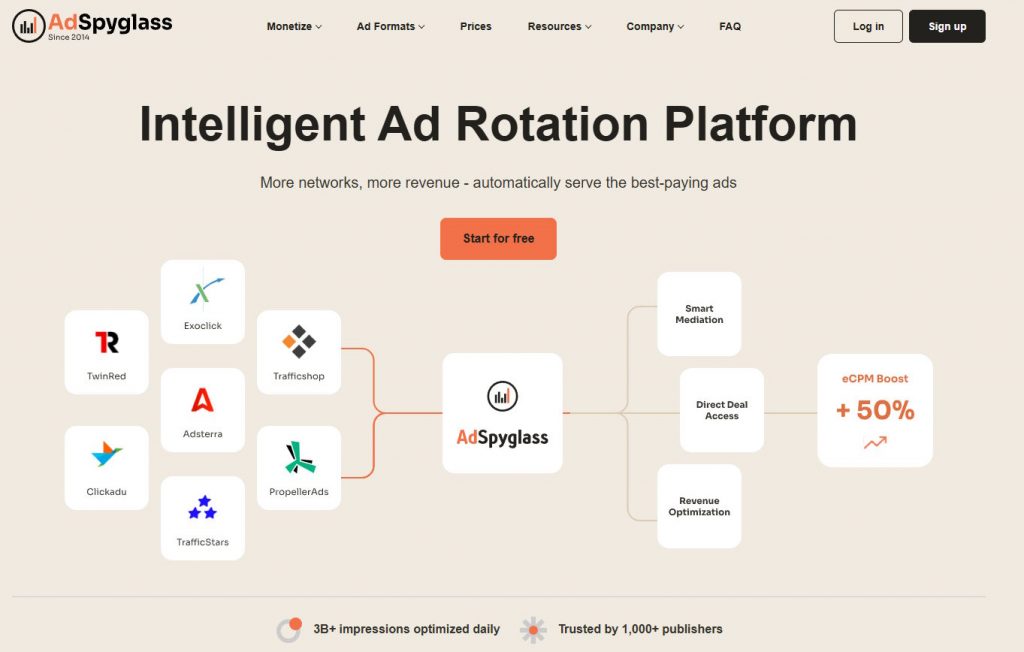For ad networks, working with major webmasters is a profitable and prestigious deal. Therefore, they are ready to offer their best conditions to gain more traffic. The most common way to attract webmasters is to offer a fixed CPM. Often this CPM is also far above the market.
On the one hand, this is convenient: you know how much money you will earn this month if the amount of traffic on your sites does not change. It is also a guarantee that you will sell all your traffic. It looks like the ad network takes all the risks of monetization. It sounds very tempting, and it’s hard to refuse such an offer.
But let’s see why ad networks are so happy to take all these risks and what it brings to you in the end.
What risks has a webmaster while working with Ad Networks?
Let’s remember that in the usual scheme, the ad network gets at least 30% of your income. So, you must understand that the network, despite the juicy conditions for webmasters, still has an extra profit. So some kind of magic happens, which can lead to the following problems.
Of course, not all ad networks use black-hat methods, but only a few. You should always check how your traffic is monetized, but you need a special check if the network offers CPM above the market.
Multi format advertising trick
What is multiformat and how ad networks use it to completely squeeze your website’s traffic?
There are several ad formats. For example, banner, popunder, VAST, push – you know all of them. It’s you who decides what to install on your site. But one single JS-tag that ad networks provide can change everything. Using it, ad networks can choose whatever ad format they want, and you won’t find out about it.
So even if you’ve earlier decided that you want to see either a push or a popunder on your site, both of them can be shown to your users. You need to be especially careful if you see a suspiciously high CPM – that’s the sign you’re being fooled.
No matter which ad format you choose, the chance it will be multi-format, is very high. And maybe, this is a method of earning here and now. But in the future, it reduces user’s loyalty, which means that you lose regular visitors, so your income falls.
In addition, if you buy traffic and violate the rules of the traffic provider without knowing it, they will stop working with you. And worst of all, Google can punish you for using formats that you don’t even know about.
Read also: Mediation Services or How To Maximize Your Website Profit
False Statistics or Shaving
How do ad networks taking advantage of providing you with fake statistics and analytics?
If you get the statistics only from the ad network, then keep in mind – they have the technical ability to manipulate numbers.
There are two options here – and both are not very good for you:
- Hiding part of the traffic. Users don’t appear in your reports, although they visited your site and saw ads. For example, when you direct traffic to the selected countries, but impressions from unpopular regions are not counted. Thus, you can cut off 5–20% of the traffic, and it isn’t so easy to notice. As a result, you do not receive part of the income.
- Hiding part of the traffic, but shows and pays all the revenue. This is a strategic move to increase CPM artificially, which may help attract new publishers.
To avoid this, use third-party statistics systems and track the actual number of impressions, and not the statistics provided by the ad network only. And consider the real CPM based on revenue and real impressions.
Frequency capping
How can frequency capping being used for fraud purposes?
There is another option, how to earn more on popunder ads. Ad network increases the number of ad impressions per user.
For example, you’ve determined that one user only sees a popunder once a day. In the same way, as with the multi-format, the Ad Network checks the IP and geolocation of the publisher and competitors and then increases the frequency capping for targets where it will be unnoticed.
Ad Networks can keep frequency capping like once a day for France, and set up to 10 times a day in, for example, North America.
They can do this not only for a specific country but, say, for a combination of a country plus a browser. For example, Canada and Firefox. It is almost impossible to track.
Popunder is a pretty annoying format. So, if the ad network shows it more than 1 time, then visitors will simply dump the site. Perhaps this will not be the same advertisement, it may be different, but the format itself is messy.
Opportunity Cost
Opportunity Cost is a very usual thing in the industry. It is most prevalent in native advertising.
Native advertising provides a low payment per click but shows ads that a high percentage of people click on. As a result, publishers lose a significant part of the traffic, as people, following ads, leave the site forever.
Conclusion? It’s always necessary to check the effect an ad has on user experience metrics (like page views/visits).
Read also: Mediation Services or How To Maximize Your Website Profit
Aggressive advertising
It happens that an ad network provides very high CTR but also poor user experience. For example, aggressive advertising – like ads that block the site until the user performs an action – for example, subscribe to push.
Also, Ad Networks may extort money by showing fictitious virus alerts. Such advertising does the most harm to your website, start from blocking on Google and up to a complete loss of visitor loyalty.
To hide overly intrusive ads, ad networks blocking it for VPN/Proxy traffic and certain locations.
On aggressive advertising, the ad network earns several times more than usual. Due to this, they get extra profit from buying traffic from the webmaster.
Taking Away Customer Database
Push format means that your users agree to receive notifications including ads. Even if they don’t browse your site, the ad can appear on a smartphone or desktop.
If JS code is used to send notifications, the customer database is gathered and kept on servers that you, as a publisher, won’t have access to. So you don’t have control what, when and how many ads will appear on the screens of those users. Ad networks don’t think about your reputation and might spam users until they get tired of this and block you.
And another thing: even if you stop working with the Ad Network, you won’t be able to take your customer database with you. And your users might get spammed after you finish your contract with the network.
We’ve got a suggestion for you to prevent this from happening: make sure you (not anyone else) collect your customer data and keep it safe.
Redirecting traffic to other resources
Redirecting it’s actually stealing your visitors. In order not to be caught, ad networks take only a small part of the traffic. And you lose not only traffic but also the trust of users who turn out to be redirected to someone else’s resource.
How to Find Cheating
To figure out whether your ad partner uses JS-code to trick you, you need to see from different locations how your website appears and how it looks on different screens. You can ask your friends or acquaintances abroad for help. Unfortunately, there is a too weak chance to discover hidden extra ads or redirecting to another website.
If that doesn’t work, try to detect those malicious practices by using third-party tools that created to look for unethical activity on websites. But these services are pretty expensive and private publishers not always can afford it.
7 Steps to Keep Your Site Safe
- Check manually your site from different countries and devices without VPN/Proxy.
- Never put someone else’s JS, if you don’t trust the source completely. It’s not about control, because you can’t control someone else’s JS. It’s about trust.
- Keep your customer data ‘inhouse’.
- Collect statistics using different methods.
- Try various services to detect aggressive advertising.
- Insert banners only with iframe function.
- Use the mediation system of advertising networks.
Manage all your ads through Ad mediation service AdSpyglass
It’s up to you to choose whether you want to get the maximum income from your sites here and now but to lose the loyalty of users, traffic providers and get a Google ban or get the maximum income every month, taking care of the loyalty of visitors, without using aggressive advertising and multi formats.
The best solution to maximize earnings from sites is a mediation system. You can sell each impression at the maximum price, without giving anyone the right to manage your advertising without letting anyone abuse these features.
You will get:
- +50% to your profit from ad networks
- ads with the highest eCPM
- 100% fill rate
- full statistics based on 100% of your traffic in realtime
- dozen of best ad networks without editing your website template
Not enough information? Watch our demo video, “how it works” video or read the AdSpyglass review.
Read also: How Ad Mediation Works
Read also: The Great Change: a Single Ad Network VS AdSpyglass
And compare all ad networks CPM rates by countries here: Top Ad Networks








